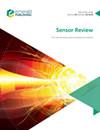A quantitative crack monitoring method based on crack disturbed voltage
IF 1.4
4区 工程技术
Q3 INSTRUMENTS & INSTRUMENTATION
引用次数: 2
Abstract
Purpose The flexible eddy current array sensor has the characteristics of lightweight and flexibility, which has a great application prospect in the field of fatigue crack monitoring. But the exciting layout and feature signal extraction have a great influence on the crack monitoring characteristics of the sensor. This paper aims to propose a method using crack disturbed voltage as sensitivity to characterize crack propagation. Design/methodology/approach Flexible eddy current array sensors with reverse and codirectional exciting layout are proposed, and the advantages and disadvantages of three characterization methods based on the change of trans-impedance amplitude, the change of the trans-impedance’s real and imaginary part and the crack disturbed voltage are compared and analyzed by finite element simulation. Finally, the fatigue crack monitoring experiment is carried out. Findings The crack disturbed voltage and the change of trans-impedance’s imaginary part can effectively characterize the crack propagation for sensors with different exciting layouts. The codirectional exciting layout sensor has better crack identification sensitivity than the reverse exciting layout sensor, especially the induction coil 2. When the distance between the exciting coil and the induction coil is 0.1, 0.2 and 0.3 mm, it is increased by 372.09%, 295.24% and 231.43%, respectively. Originality/value Crack disturbed voltage can effectively characterize the crack propagation for sensors with two different exciting layouts.基于裂纹干扰电压的裂纹定量监测方法
目的柔性涡流阵列传感器具有轻便、灵活的特点,在疲劳裂纹监测领域具有很大的应用前景。但激励布局和特征信号提取对传感器的裂纹监测特性有很大影响。本文旨在提出一种以裂纹干扰电压作为灵敏度来表征裂纹扩展的方法。设计方法提出了反向和同向励磁布置的柔性涡流阵列传感器,并通过有限元仿真比较分析了基于反阻抗幅值变化、反阻抗实部和虚部变化以及裂纹干扰电压的三种表征方法的优缺点。最后,进行了疲劳裂纹监测试验。发现裂纹干扰电压和跨阻抗虚部的变化可以有效表征不同激励布局下传感器的裂纹扩展。同向激励布局传感器比反向激励布局传感器具有更好的裂纹识别灵敏度,尤其是感应线圈。当励磁线圈与感应线圈之间的距离为0.1、0.2和0.3 mm时,分别增加了372.09%、295.24%和231.43%。独创性/valueCrack扰动电压可以有效表征两种不同激励布局下传感器的裂纹扩展。
本文章由计算机程序翻译,如有差异,请以英文原文为准。
求助全文
约1分钟内获得全文
求助全文
来源期刊

Sensor Review
工程技术-仪器仪表
CiteScore
3.40
自引率
6.20%
发文量
50
审稿时长
3.7 months
期刊介绍:
Sensor Review publishes peer reviewed state-of-the-art articles and specially commissioned technology reviews. Each issue of this multidisciplinary journal includes high quality original content covering all aspects of sensors and their applications, and reflecting the most interesting and strategically important research and development activities from around the world. Because of this, readers can stay at the very forefront of high technology sensor developments.
Emphasis is placed on detailed independent regular and review articles identifying the full range of sensors currently available for specific applications, as well as highlighting those areas of technology showing great potential for the future. The journal encourages authors to consider the practical and social implications of their articles.
All articles undergo a rigorous double-blind peer review process which involves an initial assessment of suitability of an article for the journal followed by sending it to, at least two reviewers in the field if deemed suitable.
Sensor Review’s coverage includes, but is not restricted to:
Mechanical sensors – position, displacement, proximity, velocity, acceleration, vibration, force, torque, pressure, and flow sensors
Electric and magnetic sensors – resistance, inductive, capacitive, piezoelectric, eddy-current, electromagnetic, photoelectric, and thermoelectric sensors
Temperature sensors, infrared sensors, humidity sensors
Optical, electro-optical and fibre-optic sensors and systems, photonic sensors
Biosensors, wearable and implantable sensors and systems, immunosensors
Gas and chemical sensors and systems, polymer sensors
Acoustic and ultrasonic sensors
Haptic sensors and devices
Smart and intelligent sensors and systems
Nanosensors, NEMS, MEMS, and BioMEMS
Quantum sensors
Sensor systems: sensor data fusion, signals, processing and interfacing, signal conditioning.
 求助内容:
求助内容: 应助结果提醒方式:
应助结果提醒方式:


